Plextor M5S 256GB Review
by Kristian Vättö on July 18, 2012 3:00 AM ESTRandom Read/Write Speed
The four corners of SSD performance are as follows: random read, random write, sequential read and sequential write speed. Random accesses are generally small in size, while sequential accesses tend to be larger and thus we have the four Iometer tests we use in all of our reviews. Our first test writes 4KB in a completely random pattern over an 8GB space of the drive to simulate the sort of random access that you'd see on an OS drive (even this is more stressful than a normal desktop user would see).
We perform three concurrent IOs and run the test for 3 minutes. The results reported are in average MB/s over the entire time. We use both standard pseudo randomly generated data for each write as well as fully random data to show you both the maximum and minimum performance offered by SandForce based drives in these tests. The average performance of SF drives will likely be somewhere in between the two values for each drive you see in the graphs. For an understanding of why this matters, read our original SandForce article.
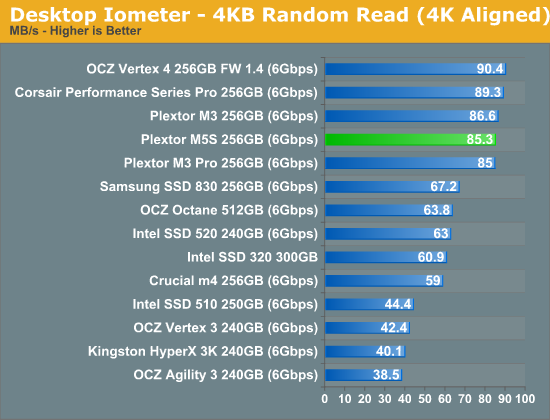
Random read and write performance has not changed at all from previous generation. This was expected because Plextor was not claiming increased random read/write performance, and the performance figures from Plextor are almost identical; The 256GB M3 Pro has 75K IOPS random read and 68K IOPS random write. The respective figures for the 256GB M5S are 73K IOPS read and 70K IOPS write.
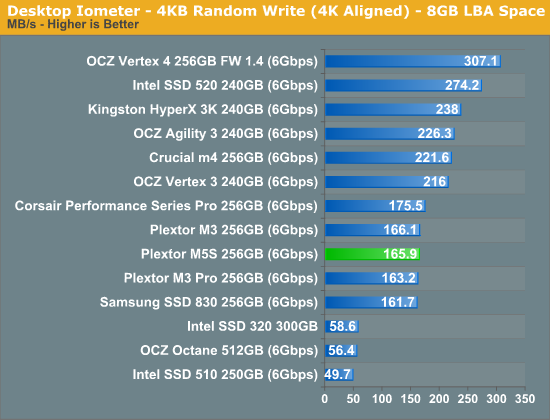
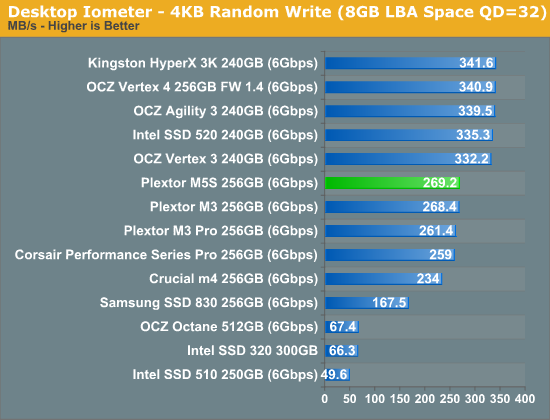
Sequential Read/Write Speed
To measure sequential performance we ran a one minute long 128KB sequential test over the entire span of the drive at a queue depth of 1. The results reported are in average MB/s over the entire test length.
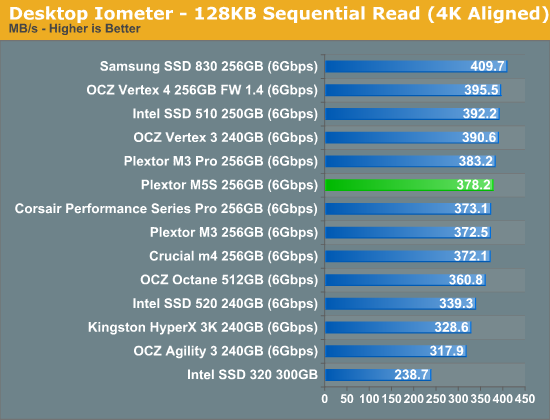
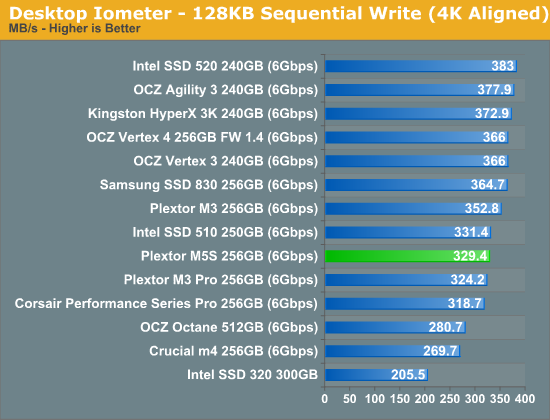
Sequential read and write performance has not changed dramatically either. Sequential read performance is right in-between the M3 and M3 Pro while sequential write performance is similar to the M3 Pro. As we discovered in our M3 Pro review, the standard M3 actually performed better in sequential write test with compressible data, although the M3 Pro was much faster when tested with incompressible data.










43 Comments
View All Comments
Kristian Vättö - Wednesday, July 18, 2012 - link
The prices were taken two days ago on July 16th, so some may have changed already. The idea is to provide some kind of idea of pricing, that's all. As you noticed already, prices change all the time so the table is only useful for a few days, hence I don't see a point in making a Europe table as well.Rick83 - Wednesday, July 18, 2012 - link
While geizhals/skinflint is a convenient tool, outside of Germany things usually get much more expensive.Occasionally a good deal in the UK, but component prices in France are often 10% higher, making even the 15 euro shipping appear attractive in some cases....
scbdpa - Wednesday, July 18, 2012 - link
So would you recommend the m3pro or m5s to a user looking to buy a plextor ssd (128gb)?Kristian Vättö - Wednesday, July 18, 2012 - link
If price is not a concern, the M3 Pro. It's noticeably faster and carries a 5-year warranty.scbdpa - Wednesday, July 18, 2012 - link
price is not the problem. What about if the machine doesn't support TRIM (a standalone audio recorder)?still get the 3pro, or get the m5s with the better garbage collection?
Thanks
name99 - Thursday, July 19, 2012 - link
Depending on what you're doing, an EXTREMELY important characteristic is power. Not idle power, but peak power (which is usually hit during sustained writes). In spite of what some people think, this number, for current SSDs, is usually substantially higher than the equivalent number for a 2.5" HD.So I'd say figure out what's the max sustained power your audio recorder can provide and use that to make your decision. If you don't know, anything below 2.5W (which is what USB-2 provides, and what most 2.5" HDs target) is safe, anything above that and you may be setting yourself up for random crashes.
kmmatney - Wednesday, July 18, 2012 - link
I don't see why one would buy this over the Crucial M4. If I understand correctly, they They both use the same NAND and a similar marvell controller. It looks liek the Plextor firmware is tweaked for better performance, but I don't think there would be any real-life difference. FYI - I have both a Samsung and a Crucial 256GB SSD in my laptop (2 bays) and I can say for certain that their real-life performance is identical.sheh - Wednesday, July 18, 2012 - link
How do you estimate the write amplification?shodanshok - Wednesday, July 18, 2012 - link
Quote, I'm interested on this.Moreover, it is a very pleasant surprise that Plextor managed to both deliver better write amplification and more aggressive garbage collector, as they are usually mutually exclusive.
Thanks.
Kristian Vättö - Wednesday, July 18, 2012 - link
I can't disclose our testing methods (they are kind of like our "trade secrets") but the basic formula for calculating WA is data written to the flash divided by data written by host. For example, if you go and copy a 1GB folder to the SSD and and the SSD ends up writing 3GB, WA would be 3x.Keep in mind that our WA estimation is a worst case scenario, not average WA.